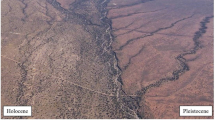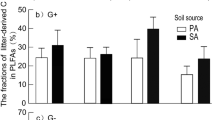Abstract
Drylands account globally for 30% of terrestrial net primary production and 20% of soil organic carbon. Present ecosystem models under predict litter decay in drylands, limiting assessments of biogeochemical cycling at multiple scales. Overlooked decomposition drivers, such as soil–litter mixing (SLM), may account for part of this model-measurement disconnect. We documented SLM and decomposition in relation to the formation of soil-microbial films and microbial extracellular enzyme activity (EEA) in the North American Chihuahuan Desert by placing mesh bags containing shrub (Prosopis glandulosa) foliar litter on the soil surface within contrasting vegetation microsites. Mass loss (in terms of k, the decay constant) was best described by the degree of SLM and soil-microbial film cover. EEA was greatest during periods of rapid litter decomposition and associated SLM. Soil-microbial film cover on litter surfaces increased over time and was greater in bare ground microsites (50% litter surface area covered) compared to shrub and grass microsites (37 and 33% covered, respectively). Soil aggregates that formed in association with decomposing leaf material had organic C and N concentrations 1.5–2× that of local surface soils. Micrographs of soil aggregates revealed a strong biotic component in their structure, suggesting that microbial decomposition facilitates aggregate formation and their C and N content. Decomposition drivers in arid lands fall into two major categories, abiotic and biotic, and it is challenging to ascertain their relative importance. The temporal synchrony between surface litter mass loss, EEA, biotic film development, and aggregate formation observed in this study supports the hypothesis that SLM enhances decomposition on detached litter by promoting conditions favorable for microbial processes. Inclusion of interactions between SLM and biological drivers will improve the ability of ecosystem models to predict decomposition rates and dynamics in drylands.







Similar content being viewed by others
References
Adair EC, Hobbie SE, Hobbie RK (2010) Single-pool exponential decomposition models: potential pitfalls in their use in ecological studies. Ecology 91:1225–1236
Adeel Z, Safriel U, Niemeijer D, White R, Kalbermatten G, Glantz M (2005) Millennium ecosystem assessment. Ecosystems and human well-being: desertification synthesis. World Resource Institute, Washington, DC
Allison SD, Gartner T, Holland K, Weintraub MN, Sinsabaugh RL (2007) Soil enzymes: linking proteomics and ecological process. Manual of environmental microbiology. ASM Press, Washington, DC, pp 704–711
Alster CJ, German DP, Lu Y, Allison SD (2013) Microbial enzymatic responses to drought and to nitrogen addition in a southern California grassland. Soil Biol Biochem 64:68–79
Archer SR, Andersen EM, Predick KI, Schwinning S, Steidl RJ, Woods SR (2017) Woody plant encroachment: causes and consequences. In: Briske DD (ed) Rangeland systems: processes, management and challenges. Springer, New York
Austin AT (2011) Has water limited our imagination for aridland biogeochemistry? Trends Ecol Evol 26:229–235
Austin AT, Vivanco L (2006) Plant litter decomposition in a semi-arid ecosystem controlled by photodegradation. Nature 442:555–558
Barnes PW, Throop HL, Hewins DB, Abbene ML, Archer SR (2012) Soil coverage reduces photodegradation and promotes the development of soil-microbial films on dryland leaf litter. Ecosystems 15:311–321
Barnes PW, Throop HL, Archer SR, Breshears DD, McCulley R, Tobler M (2015) Sunlight and soil–litter mixing: drivers of litter decomposition in drylands. Prog Bot 76:273–302
Bird SB, Herrick JE, Wander MM, Wright SF (2002) Spatial heterogeneity of aggregate stability and soil carbon in semi-arid rangeland. Environ Pollut 116:445–455
Cacchio P, Ercole C, Cappuccio G, Lepidi A (2003) Calcium carbonate precipitation by bacterial strains isolated from a limestone cave and from a loamy soil. Geomicrobiol J 20:85–98
Eldridge DJ, Bowker MA, Maestre FT, Roger E, Reynolds JF, Whitford WG (2011) Impacts of shrub encroachment on ecosystem structure and functioning: towards a global synthesis. Ecol Lett 14:709–722
Ercole C, Cacchio P, Botta AL, Centi V, Lepidi A (2007) Bacterially induced mineralization of calcium carbonate: the role of exopolysaccharides and capsular polysaccharides. Microsc Microanal 13:42–50
Field CB, Behrenfeld MJ, Randerson JT, Falkowski P (1998) Primary production of the biosphere: integrating terrestrial and oceanic components. Science 281:237–240
Gallo ME, Porras-Alfaro A, Odenbach KJ, Sinsabaugh RL (2009) Photoacceleration of plant litter decomposition in an arid environment. Soil Biol Biochem 41:1433–1441
Gibbens RP, McNeely RP, Havstad KM, Beck RF, Nolen B (2005) Vegetation changes in the Jornada Basin from 1858 to 1998. J Arid Environ 61:651–668
Harmon ME, Nadelhoffer KJ, Blair JM (1999) Measuring decomposition, nutrient turnover, and stores in plant litter. In: Robrtson GP, Coleman DC, Bledsoe CS, Sollins P (eds) Standard soil methods for long-term ecological research. Oxford University Press, Cary, pp 202–240
Harris D, Horwáth WR, van Kessel C (2001) Acid fumigation of soils to remove carbonates prior to total organic carbon or carbon-13 isotopic analysis. SSAJ 65:1853–1856
Hennessy JT, Gibbens RP, Tromble JM, Cardenas M (1983) Vegetation changes from 1935 to 1980 in mesquite dunelands and former grasslands of southern New Mexico. J Range Man 36:370–374
Herrick JE, Whitford WG, de Soyza AG, Van Zee JW, Havstad KM, Seybold CA, Walton M (2001) Field soil aggregate stability kit for soil quality and rangeland health evaluations. CATENA 44:27–35
Hewins DB, Throop HL (2016) Leaf litter decomposition is rapidly enhanced by the co-occurrence of monsoon rainfall and soil-litter mixing across a gradient of coppice dune development in the Chihuahuan Desert. J Arid Environ 129:111–118
Hewins DB, Archer SR, Okin GS, McCulley RL, Throop HL (2013) Soil-litter mixing accelerates decomposition in a Chihuahuan Desert grassland. Ecosystems 16:183–195
Hulme M (1996) Recent climatic change in the world’s drylands. Geophys Res Lett 23:61–64
King JY, Brandt LA, Adair EC (2012) Shedding light on plant litter decomposition: advances, implications and new directions in understanding the role of photodegradation. Biogeochemistry 111:57–81
Lal R (2004) Carbon sequestration in dryland ecosystems. Environ Man 33:528–544
Lee H, Rahn T, Throop HL (2012) An accounting of C-based trace gas release during abiotic plant litter degradation. Glob Change Biol 18:1185–1195
Lee H, Fitzgerald J, Hewins DB, McCulley RL, Archer SR, Rahn T, Throop HL (2014) Soil moisture and soil-litter mixing effects on surface litter decomposition: a controlled environment assessment. Soil Biol Biochem 72:123–132
Levi EM (2017) Foliar and woody litter decomposition in a shrub-invaded Sonoran Desert grassland. Ph.D. Dissertation, University of Arizona, Tucson
Li J, Okin GS, Alvarez L, Epstein H (2007) Quantitative effects of vegetation cover on wind erosion and soil nutrient loss in a desert grassland of southern New Mexico, USA. Biogeochemistry 85:317–332
Monger HC, Daugherty LA, Lindemann WC, Liddell CM (1991) Microbial precipitation of pedogenic calcite. Geology 19:997–1000
Oades JM (1993) The role of biology in the formation, stabilization and degradation of soil structure. Geoderma 56:377–400
Okin GS (2008) A new model of wind erosion in the presence of vegetation. J Geophys Res 113, CiteID F02S10
Olson JS (1963) Energy storage and the balance of producers and decomposers in ecological systems. Ecology 44:322–331
Parton W, Silver WL, Burke IC, Grassens L, Harmon ME, Currie WS, King JY, Adair EC, Brandt LA, Hart SC, Fasth B (2007) Global-scale similarities in nitrogen release patterns during long-term decomposition. Science 315:361–364
Saetre P, Stark JM (2005) Microbial dynamics and carbon and nitrogen cycling following re-wetting of soils beneath two semi-arid plant species. Oecologia 142:247–260
Saiya-Cork KR, Sinsabaugh RL, Zak DR (2002) The effects of long term nitrogen deposition on extracellular enzyme activity in an Acer saccharum forest soil. Soil Biol Biochem 34:1309–1315
Schimel J, Balser TC, Wallenstein MD (2007) Microbial stress-response physiology and its implications for ecosystem function. Ecology 88:1386–1394
Schlesinger WH, Bernhardt ES (2013) Biogeochemistry: an analysis of global change. Academic press, New York, pp 135–225
Schlesinger WH, Raikes JA, Hartley AE, Cross AF (1996) On the spatial pattern of soil nutrients in desert ecosystems. Ecology 77:364–374
Sinsabaugh RL, Carreiro MM, Repert DA (2002) Allocation of extracellular enzymatic activity in relation to litter composition, N deposition, and mass loss. Biogeochemistry 60:1–24
Sinsabaugh RL, Lauber CL, Weintraub MN, Ahmed B, Allison SD, Crenshaw C, Contosta AR, Cusack D, Frey S, Gallo ME, Gartner TB, Hobbie SE, Holland K, Keeler BL, Powers JS, Stursova M, Takacs-Vesbach C, Waldrop MP, Wallenstein MD, Zak DR, Zeglin LH (2008) Stoichiometry of soil enzyme activity at global scale. Ecol Lett 11:1252–1264
Six J, Elliott ET, Paustian K (1999) Aggregate and soil organic matter dynamics under conventional and no-tillage systems. SSAJ 63:1350–1358
Six J, Elliott ET, Paustian K (2000) Soil macroaggregate turnover and microaggregate formation: a mechanism for C sequestration under no-tillage agriculture. Soil Biol Biochem 32:2099–2103
Six J, Frey SD, Thiet RK, Batten K (2006) Bacterial and fungal contributions to carbon sequestration in agroecosystems. SSAJ 70:555–569
Song X, Peng C, Jiang H, Zhu Q, Wang W (2013) Direct and indirect effects of UV-B exposure on litter decomposition: a meta-analysis. PLoS ONE 8:e68858
Stursova M, Sinsabaugh RL (2008) Stabilization of oxidative enzymes in desert soil may limit organic matter accumulation. Soil Biol Biochem 40:550–553
Throop HL, Archer SR (2007) Interrelationships among shrub encroachment, land management, and litter decomposition in a semidesert grassland. Ecol Appl 17:1809–1823
Throop HL, Archer SR (2008) Shrub (Prosopis velutina) encroachment in a semidesert grassland: spatial–temporal changes in soil organic carbon and nitrogen pools. Glob Change Biol 14:2420–2431
Throop HL, Archer SR (2009) Resolving the dryland decomposition conundrum: some new perspectives on potential drivers. Prog Bot 70:171–194
Tisdall JM, Oades JM (1982) Organic matter and water-stable aggregates in soils. Eur J Soil Sci 33:141–163
Wainwright J (2006) Climate and climatological variations in the Jornada Basin. In: Havstad KM, Huenneke LF, Schlesinger WH (eds) Structure and function of a Chihuahuan Desert ecosystem. Oxford University Press, Oxford, pp 44–80
Whitford WG (2002) Ecology of desert systems. Academic Press, New York, pp 275–301
Whitford WG, Meentemeyer V, Seastedt TR, Cromack K, Crossley DA, Santos P, Todd RL, Waide JB (1981) Exceptions to the AET model: deserts and clear-cut forest. Ecology 62:275–277
Acknowledgements
Laboratory and field assistance from E. Morrison, J. Fitzgerald, and E. Velasco is appreciated. We thank D. Warnock for technical support with EEA, P. Cooke for assistance with microscopy, J.A. Perez for statistical consultation and W.G. Whitford, B. Bestelmeyer, and J. Anderson for helpful discussions in planning this work. Constructive feedback from two anonymous reviewers helped improve the manuscript. This work was supported by the US National Science Foundation (DEB 0815808 to HT, DEB 0816162 to SA), T&E Inc. (to DBH), the New Mexico State University Biology Graduate Student Organization (to DBH), and Arizona Agricultural Experiment Station project ARZT-1360540-H12-199 (to SA).
Author information
Authors and Affiliations
Corresponding author
Additional information
Communicated by Wayne Polley.
Rights and permissions
About this article
Cite this article
Hewins, D.B., Sinsabaugh, R.L., Archer, S.R. et al. Soil–litter mixing and microbial activity mediate decomposition and soil aggregate formation in a sandy shrub-invaded Chihuahuan Desert grassland. Plant Ecol 218, 459–474 (2017). https://doi.org/10.1007/s11258-017-0703-4
Received:
Accepted:
Published:
Issue Date:
DOI: https://doi.org/10.1007/s11258-017-0703-4




